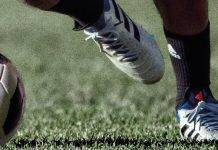In the world of sports, the right equipment is crucial not only for enhancing performance but also for preventing injuries.
Among all the gear athletes use, footwear plays a pivotal role in ensuring safety on the field, court, or track. Wearing appropriate shoes can significantly reduce the risk of sports-related injuries, making it essential for athletes of all levels to pay close attention to their footwear choices.
Recent studies have highlighted the strong correlation between proper footwear and a decrease in injuries such as sprains, strains, and fractures. Shoes designed specifically for a sport provide the necessary support, traction, and cushioning required for the movements involved.
For example, running shoes are engineered to absorb shock and support forward motion, while basketball shoes offer ankle support for quick directional changes.

Key Considerations for Selecting the Right Footwear
Proper Fit: Shoes should comfortably accommodate the foot without being too tight or too loose. An ill-fitting shoe can lead to blisters, calluses, and more severe injuries due to improper foot alignment.
Support and Stability: Adequate arch support and heel stability are essential, especially for sports involving running and jumping. This support helps in maintaining proper foot posture and reduces stress on muscles and joints.
Traction: The sole of the shoe should offer appropriate grip for the playing surface. This reduces the risk of slipping, which can lead to falls and associated injuries.
Cushioning: Good cushioning absorbs impact forces, protecting the feet and lower limbs from stress injuries. This is particularly important in high-impact sports.
Sport-Specific Features: Different sports have unique demands. Cleats for soccer or football provide traction on grass, while court shoes for tennis have non-marking soles suitable for hard surfaces.
Material and Durability: High-quality materials enhance comfort and prolong the shoe’s life, offering consistent protection over time.
Tips for Athletes
Assess Foot Type: Understanding whether you have flat feet, high arches, or neutral arches can guide you in selecting shoes that offer the best support.
Replace Worn-Out Shoes: Over time, shoes lose their supportive features. Regularly check for signs of wear and replace shoes as needed.
Consult Professionals: Seek advice from coaches, podiatrists, or specialized sports stores to find footwear that meets your specific needs.
Break Them In: Gradually introduce new shoes into your training to allow your feet to adjust, reducing the risk of discomfort or injury.
Key Findings
Injury Reduction Linked to Shoe Design:
The study found that athletes wearing footwear specifically designed for their sport—whether soccer, football, baseball, or running—reported up to 25% fewer lower-body injuries compared to those using generic or ill-fitting shoes.
Researchers point to advancements in cleat patterning, midsole cushioning, and ankle support as primary contributors to reduced ankle sprains, stress fractures, and knee injuries.
Importance of Fit and Support:
Beyond design innovations, the report underscores the critical role that proper shoe fit plays in injury prevention. Shoes that are too loose or too tight can lead to blisters, chronic pain, and a heightened risk of serious soft-tissue injuries.
According to the findings, athletes who took extra care in selecting and regularly replacing worn-out footwear saw a 30% drop in foot- and ankle-related complaints.
Impact Across Different Sports:
While cleated sports like soccer and football were a primary focus, the data also revealed that sports such as basketball, running, and tennis saw notable benefits from sport-specific footwear.
High-impact movements—sprinting, rapid direction changes, or repeated jumps—place significant stress on the lower body. Proper cushioning, arch support, and traction systems were repeatedly cited as key injury-prevention features in these disciplines.
Expert Insights
Dr. Marianne Collins, lead researcher on the project and a renowned sports medicine specialist, emphasized the multifaceted benefits uncovered by the study:
“This research confirms that wearing the right shoes goes well beyond comfort. The structural design, fit, and support of your footwear directly correlate to injury rates. By selecting cleats or sneakers tailored to your sport and foot type, you can significantly decrease your risk of common injuries such as ankle sprains, shin splints, and ligament tears.”
Professional athletes also echoed these sentiments. In interviews conducted by CleatsReport.com, soccer star Jamal Meeks highlighted the role of modern footwear technology in extending his career:
“Foot injuries used to keep me off the field for weeks at a time. Since I switched to a more supportive cleat design, I’ve stayed healthier and on top of my game. It’s a simple change that can have huge benefits.”
Practical Takeaways
- Consult a Professional: Athletes are advised to visit sports-focused shoe specialists or podiatrists who can assess gait, foot type, and performance needs.
- Regular Shoe Checks: Replace cleats and sneakers at recommended intervals—often sooner than you might expect. Worn-out soles and compromised support structures can undermine performance and invite injury.
- Sport-Specific Footwear: Whether you run marathons or play weekend soccer matches, choosing footwear designed for your activity can make a significant difference in injury prevention.
- Proper Warm-Up and Conditioning: Even the best footwear cannot replace the need for a balanced training regimen. Combine good shoes with dynamic warm-ups, strength training, and flexibility exercises for the best results.
Looking Ahead
With the publication of this report, CleatsReport.com aims to raise awareness among athletes, coaches, and sports enthusiasts about the critical role of proper footwear in injury prevention.
As sports grow more competitive and athletic performance continues to push new boundaries, the study’s insights serve as a timely reminder: the foundation of success often begins quite literally at an athlete’s feet.
For more details, the full report is available on CleatsReport.com. Interested parties can access in-depth data, expert analyses, and additional recommendations tailored to various sports and training programs.
By prioritizing proper footwear, athletes can not only enhance their performance but also safeguard their health. Investing time and resources into selecting the right shoes is a proactive step toward a safer and more successful sporting experience.
The significance of appropriate footwear in sports cannot be overstated. With the right shoes, athletes can perform at their best while minimizing the risk of injury. As sports continue to evolve and place greater physical demands on participants, understanding and implementing proper footwear choices remain a fundamental aspect of athletic preparedness and overall well-being.
About CleatsReport.com
CleatsReport.com is a leading online resource dedicated to educating athletes, coaches, and sports enthusiasts about the latest developments in footwear technology, injury prevention, and performance optimization.
Through rigorous research, expert interviews, and product reviews, CleatsReport.com strives to empower the athletic community with reliable, science-backed information.







































